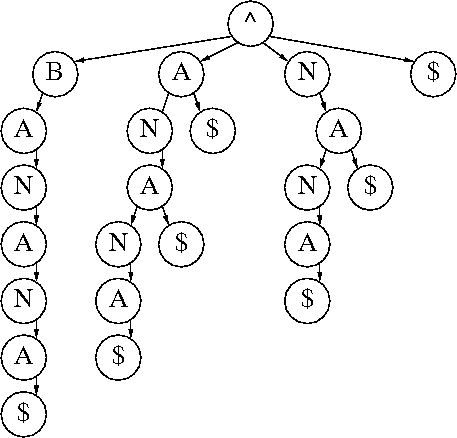Question
Given a string, find the number of distinct substrings of the string. Example:
input = “aaaa”,
output = 4 (the 4 substrings are “a”, “aa”, “aaa”, “aaaa”)
input = “abcd”,
output = 10 (“a”, “b”, “c”, “d”, “ab”, “bc”, “cd”, “abc”, “bcd”, “abcd”)
input = “banana”,
output = 15 (“a”, “an”, “ana”, “anan”, “anana”, “b”, “ba”, “ban”, “bana”, “banan”, “banana”, “n”, “na”, “nan”, “nana”)
This is also a question on SPOJ.
Solution
This is a very good question, which tests Suffix tree, LCP and string manipulation knowledges.
The solution is to build a suffix tree. This is because:
If you look through the prefixes of each suffix of a string, you have covered all substrings of that string.
There are 2 implementations. First one is slightly simpler.
Implementation 1
Suffix array + LCP (longest common prefix). Take “Banana” as input, then the suffixes:
0) BANANA
1) ANANA
2) NANA
3) ANA
4) NA
5) A
Sort it:
5) A
3) ANA
1) ANANA
0) BANANA
4) NA
2) NANA
Then we start calculate number of substring (that is prefixes of suffix). After removing duplicated prefix, the count is:
5) A - 1
3) ANA - 2
1) ANANA - 2
0) BANANA - 6
4) NA - 2
2) NANA - 2
Total number is:
1 + 2 + 2 + 6 + 2 + 2 = 15
But wait, realize something? “A” is simply duplicate substring in “ANA”, which appers in “ANANA”. Keep this in mind, cuz we need to observe this in the 2nd implementation, too.
Finally, the total number is calculated like this:
for each suffix
ans += length(suffix) - LCP(suffix, previous suffix)
For more details, read here.
Implementation 2
Build a suffix tree, like this:

Number of substrings is simply the sum of levels of each leaf. For the 3 branches of the suffix tree, number of levels are: 6, 5 and 4 respectively. Total = 15.